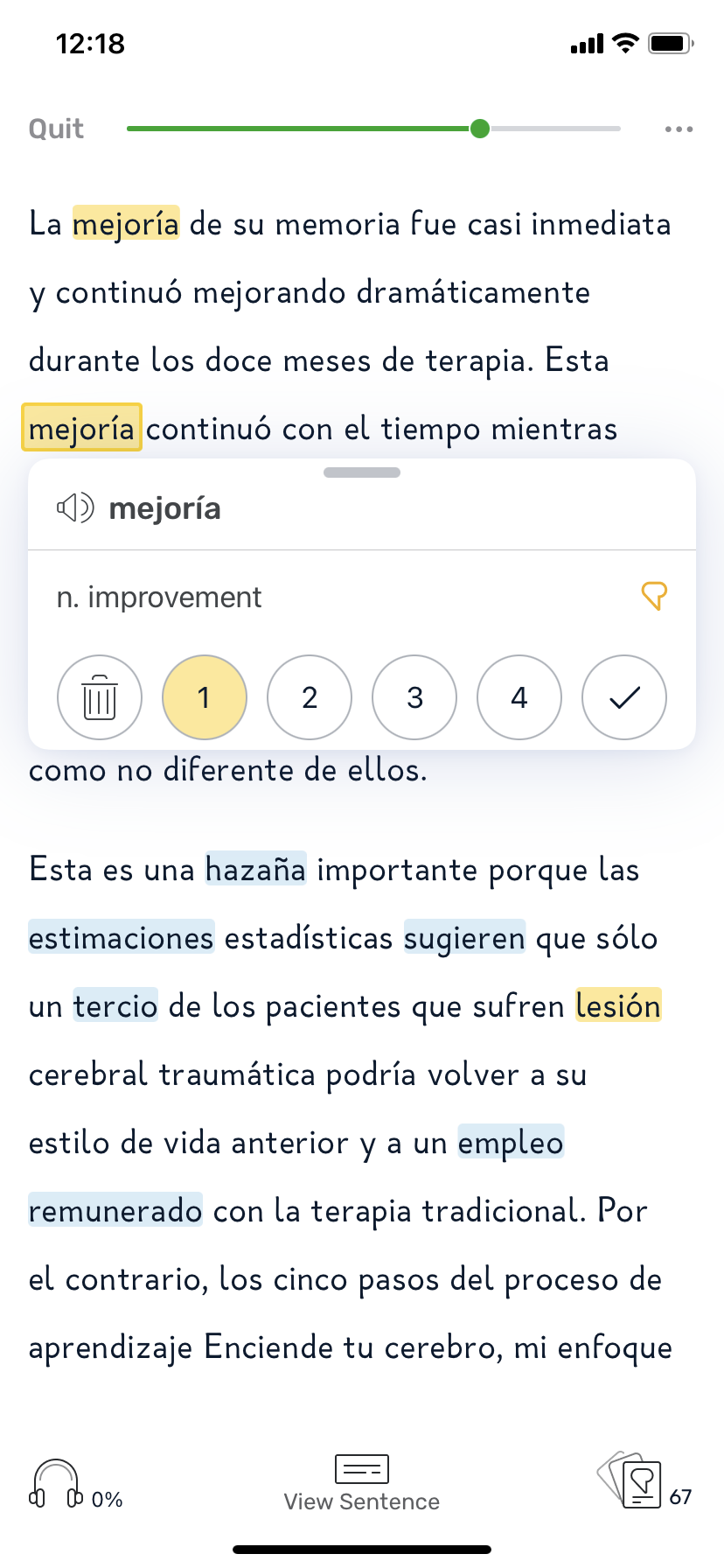The Blueprint to Spanish Fluency (Part 1) - Reading Books
*This blog is reader-supported. I may earn a commission for purchases made through links in this post. Read full Affiliate Disclaimer here.
Table of Contents
The power of reading books
The complete opposite way
Isn’t reading books a bit too difficult?
What to read?
Learning Spanish without even trying to
When is a good time to start reading a book?
How to read effectively
“I’m past the beginning stages of Spanish, now what??”
A few months ago, I shared with you what to do when you’re just starting out learning Spanish in the blog post: 1st week of learning Spanish - What I did.
That post aimed to give you some clear tips on how to get the foundations and basics in place. If that’s where you’re currently at check out that post.
Or my comprehensive review of Spanish Uncovered, if you’re someone who thrives on having a more comprehensive and clear step-by-step approach.
So what do you do when you’ve gone through the basics and materials targeted at beginners?
The Pimsleur, Language Transfer, the LingQ mini stories or whatever you’ve used to get a foundation in the language.
How do you get past the simple materials and start to get into REAL Spanish? The Spanish that native speakers use and that you hear on TV.
The intermediate stage is really when you’ll start to be able to do this and it’s a really fun stage to get to.
It’s where you’ll be able to learn from more interesting content such as TV shows, YouTube, podcasts, books and so on. Content not aimed at language learners but for actual native speakers.
This is when language learning gets really fun!
With Spanish we both have the luxury of having a lot of resources to choose from, but by the same token it can sometimes be an overwhelming amount to choose from.
Not only that, it needs to be something that is simple and interesting enough so that you can do it consistently.
And consistency is one of the biggest predictors of success or failure when learning a language. For me, this was especially true since I’ve been learning 3 languages at the same time the whole time I’ve been learning Spanish.
I needed a way to make sure learning was a no-brainer and I could get it done every day without fail.
Even during the days when I’m not feeling well or when I simply don’t feel like it.
And if you’re busy (like I’m sure most of you are) with hobbies, a family, and other things you want to do - these posts are going to be what you’re looking for.
This is going to be a series of 4 blog posts where I’m going to give you a window into my own language learning methods and routines. A peak into what I’ve done to successfully improve my Spanish every day with very little effort.
In these posts I will be focusing on the only 4 things you need (outside of why you’re actually learning Spanish) to successfully take your Spanish to the next level.
Using these four “pillars” you will be able to not only progress quickly, but you’ll have a blast doing it.
So grab your coffee, tea or beverage of choice and let’s get into one of my favorite language learning activities!
The power of reading books
I’m a big believer in reading and specifically reading books.
It is one of the best ways for us to access valuable information, new ways of thinking and great stories.
It’s also one of the most effective language learning tools.
Acquiring a lot of words should be our main focus when learning a language. Because not knowing enough words is our biggest barrier to not understanding what people are saying.
And reading is the fastest and most efficient way to expand the sheer amount of words that we know.
Reading books is also a lot of fun.
Because by picking books to read that is actually interesting to you (instead of learning from a cookie cutter language learning book that’s probably not going to be very interesting) you’re customizing your learning experience to be the perfect fit for you.
It really is something that will accelerate your learning more than probably anything out there. A bold statement I know, but reading really is that effective.
I’ve heard that we only use 10% or so words of the available vocabulary when speaking. Whether that number is accurate or not I don’t know. But what I do know is that by reading books you not only get access to quality language but you get exposed to a much greater variety of words being used.
And exposure to the language is what we need in order to learn.
The complete opposite way
I personally don’t try to find a Spanish book that I think might be interesting to read (I mean if I come across one then great!). But I actually do things the complete opposite way.
Let me explain…
I constantly get book recommendations from people I know. Or I just come across books that I’d like to read. 99% of the time these are books written in English, which doesn’t really help my Spanish.
So whenever I hear about or discover a book I’d like to read - I go and check to see if it’s available in the language I’m learning. In this case - Spanish.
If it’s available, I just add it to my notes app on my iPhone, along with the link to the online bookstore where I can buy it as an e-book.
This helps a lot because whenever I finish my current book I don’t have to go searching for a new book, but I already have a list to choose from that’s full of interesting books I’d like to read.
I’m personally mostly interested in reading books in the realm of personal development, but sometimes I also like to relax with just immersing myself in a good story or a fantasy book from time to time (reading the 4th Witcher book in Finnish right now).
“Acquiring a lot of words should be our main focus when learning a language. […] And reading is the fastest and most efficient way to expand the sheer amount of words that we know.”
Isn’t reading books a bit too difficult?
If you pick up a regular paperback book at this point of your learning, then it’s probably going to be too difficult and slow to get through.
There are just too many words you don’t know.
This is where my favorite language learning app LingQ comes in. It’s without a doubt the one resource I would choose if I could only use one thing when learning a language.
LingQ is like the bridge between you and your current level - and the content that you would like to consume.
LingQ (sign up through this link and get the best discount that I’ve been able to find) makes it so easy and convenient to use material that would otherwise be too difficult and makes it accessible.
This is when language learning becomes super enjoyable. Because you’re now choosing material based on your own personal interests and likings and not based on your language learning goals.
I was talking to a friend of mine and she recommended the book “Switch on your brain” by Dr. Caroline Leaf. I was already familiar with her name and the book sounded very interesting.
So I went to search for it to see if it was available in Spanish, and lo and behold it was! (“Enciende tu Cerebro” is the Spanish title)
So I just bought the e-book version, drag-and-dropped it into my LingQ app and voilà - it was now my Spanish learning resource.
Dr Leaf is a Christian author who has researched about how our thoughts influence our health and how to be able to trap and detox ourselves from those toxic thoughts that rob us of our happiness and success.
It’s a combination of how the Bible aligns with scientific discoveries about how our brains operates.
Very fascinating stuff and I’ve been getting a lot of value from reading it and learning new and highly useful tools and mindsets for my day to day life.
I just happen to be learning Spanish at the same time while diving into an interesting topic!
Learning Spanish without even trying to
The point isn’t that you need to go and get this particular book, but to find one that peaks your interest.
Something that you would enjoy reading in your native language.
This is super effective because it takes away the focus on learning Spanish and shifts it on trying to understand the content of the book.
Which just happens to be in Spanish.
So you’re learning without even trying to. Amazing things to happen when we don’t try, but simply spend the time.
Reading using LingQ’s amazing dictionary pop-up system makes it a breeze to read in Spanish (or any language) since you don’t have to stop to look up words. It’s right there built into the experience of the app. You can just click on every word, save the definitions and it keeps track of how many words you know (it has many other features as well).
This is a great method because you’re not having to review anything. The only review you’re getting is what naturally occurs in the texts you’re reading. Your only objective is to get from point A to B.
From the start of the book to the end.
This boosts motivation since you get a sense of forward motion and constant progress.
“Amazing things to happen when we don’t try, but simply spend the time.”
Learn more about this concept and my language learning secrets by downloading my FREE Guide Intuitive Language Secrets:
When is a good time to start reading a book?
This is an important question and is of course dependent on the complexity of the text that you’re reading.
In my experience, once you get to around 2,000 “known words” in Spanish with LingQ then that’s usually a good place to start reading a regular book in the language.
How long it takes for you to get there depends of course on how much time you spend every day, but I got there after around 3-4 months with a pretty relaxed reading routine of around 10-15 mins a day.
The secret is to just do it every single day, but more on that in a future post.
What to read?
I recommend to start with autobiographies or personal development books (that aren’t about too technical topics). They tend to be the easiest places to start. Fantasy books, for example, are more complicated since they use vocabulary not often used in every day language.
The most important thing however is that you’re interested in the book you’re reading (then you can even get away with it being a bit more difficult).
You’re going to learn the most and have the best time when doing that.
And when you’re captivated by the content you’re reading - learning happens by-accident.
How to read effectively
Knowing how to read is just as important as what to read.
So when you’re reading the book that you’ve picked out and you’re excited to read - just focus on understanding the meaning of what you’re reading.
Don’t try to memorize anything.
I can’t stress this enough. As soon as you understand the meaning of the sentence - move on and don’t look back.
Don’t try to figure out the grammar or understanding logically the function of the words in relationship with each other. All of that will become clearer and clearer throughout the journey of enough reading and exposure.
So rather than trying to understand how the language works, just try to rather notice things.
Any patterns that you see, expressions, or how certain words tend to be used. Notice without analyzing. Because not everything in languages makes logical sense (and that’s for sure true in Spanish!).
Reading in a foreign language doesn’t have to be more complicated than that. And when you do it based on your own interests and passions - it’s so much fun.
You forget you’re even learning Spanish. The learning is just a natural by-product of being exposed to the language through words on the page. Patterns and word order start to make sense. You start getting more and more of an intuitive feel for the language.
You’re driven not mainly by improving in the language, but by wanting to consume the content. To learn new skills and new ways of thinking. To find out what happens next in the story.
And by using LingQ you constantly see the amount of “known words” go up, which confirms that you’re improving.
Reading has been the nr #1 thing I have done to learn Finnish and I’m finding a lot of enjoyment and success using it to learn Spanish.
What types of books do you enjoy reading?
How would you feel snuggling up with a blanket and a cup of coffee or tea on the balcony and just enjoy a good book?
If that sounds like you then you have a very powerful and highly enjoyable language learning tool on your hands.
———
In the next post The Blueprint to Spanish Fluency (Part 2) - Listening I will show you what I have done and am doing to improve the skill that is actually the most important to develop in order to be able to speak Spanish well.



